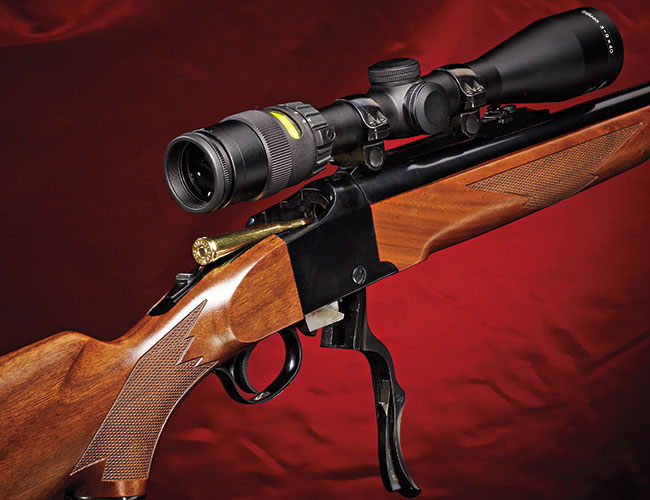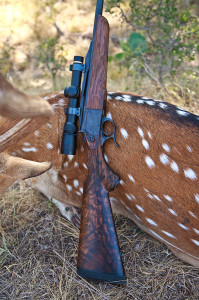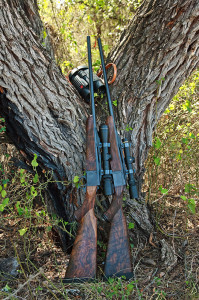The Ruger No. 1 is among the most iconic single shot rifles and has been in use for decades.
The ram was alone. Because he wasn’t the dominant male, he lacked a black and white coat and therefore couldn’t have his own harem. The ladies of this species are very proper, only tuxedo-clad blackbucks get to breed. Still, he had to go. The landowner wanted all of the non-native species removed from his ranch. It was July in the Texas hill country, and the thermometer was still well North of 100 degrees, even at dusk. With the heat, the shorts and the way the ram walked through the scrub, it was easy to forget that I wasn’t in equatorial Africa somewhere.
I put the tiny .270 on shooting sticks and cocked the side hammer. The fat crosshairs of the 5x scope covered the ram’s entire shoulder at about 250 yards, and he wasn’t going to stop walking, but I knew that I could make the shot. When the trigger broke, the ram dropped as if he’d fallen into a hole, and there was no need for a second shot. That blackbuck was the first animal to fall to the then-new Luxus Arms Model 11, a break-action single shot with Turkish walnut that will make you cry. Why a new single shot when technology has brought us repeating rifles and even semiautos? Let’s talk about that.
Instead of focusing on what the single shot won’t do, let us start by focusing on the things that it does well. For starters, single shots are simple: There are no feeding issues to concern oneself with because it does not feed itself. Extraction and or ejection are literally straightforward, so they are not generally of concern, at least mechanically. The rifle is either loaded or unloaded. There’s no mystery of rounds in the magazine versus rounds in the chamber. Strength is almost never an issue, particularly with the falling block designs.
Although much hunting in the East and Midwest is done from stands these days, the art of stalking is still alive and well in some corners. This is where the single shot rules. Because single shots aren’t burdened with a magazine, they can be slim and trim. For the same reason, they are roughly 3 inches shorter overall than other rifles with equal barrel lengths. So, we have rifles that are stronger, shorter, slimmer and lighter than the competition — where’s the disadvantage again? Ah yes, the limitation of the single round. There is a case to be made that this is actually an advantage, that the psychology of the single round will make the hunter choose his shot carefully. This is a tough thing to prove, but I do think that it has merit. Beyond that, I can only draw from my own experience and say that I can recall few instances where I fired more than a single round at a game animal.
Two years ago, I took three shots at an elk and lost it. If I had it to do over again, I wouldn’t wish for a larger magazine. I would take a moment longer to ensure that the first round was true. More than a decade ago in Africa, I put several 200-grain A-Frames into a Gemsbok before he went down for good. A gemsbok is a big, tough animal that sometimes takes a lot of killing. I had a similar experience with a blue wildebeest on a later safari, but, this time, the culprit was the poor cup and core bullet construction of the ammo that accompanied the camp rifle. A magazine made life easier in both cases, but single-loading rounds would not have caused me to lose either animal, in my estimation. So, a single shot would have been a slight disadvantage in two circumstances out of several dozen during my lifetime — not necessarily a reason to relegate them to the back of the safe. The only thing a single shot doesn’t do well is fire subsequent shots with blinding speed.
There’s a final virtue of the single shot that should make it a consideration for every shooter and hunter’s collection: It is an ideal firearm for teaching new shooters and hunters. The simplicity and safety of a single shot allows the novice to focus on the fundamentals of placing a single shot with precision rather than distractions. When my children are old enough to shoot and hunt, I’m likely to put single shots into their hands and teach them to make the first shot count.
Single shots are available in nearly every price range from affordable models such as the T/C Encore and Ruger No. 1, to exquisite customs like the Hagn. Therefore, their virtues are available to nearly everyone. Single shots can be made in rimfire calibers up through the largest cartridges ever carried afield such as the .700 Nitro and the four- and eight-bore elephant hammers. A single shot wouldn’t be my first choice for dangerous game, as I know of too many instances where follow-up shots saved a life. But, to be fair, many an elephant and buffalo were taken with the Farquharsons.
Semiautomatic rifles dominate today’s marketplace, and I own more than my fair share. That said, older designs such as the single shot maintain a valuable place in the shooting and hunting arsenal. The single shot has more strengths than weaknesses and has endured while other “more advanced” designs have languished into the trash heap of firearms history. Next time you head to the range or into the woods, leave the magazine guns at home and focus on the shot that counts.




